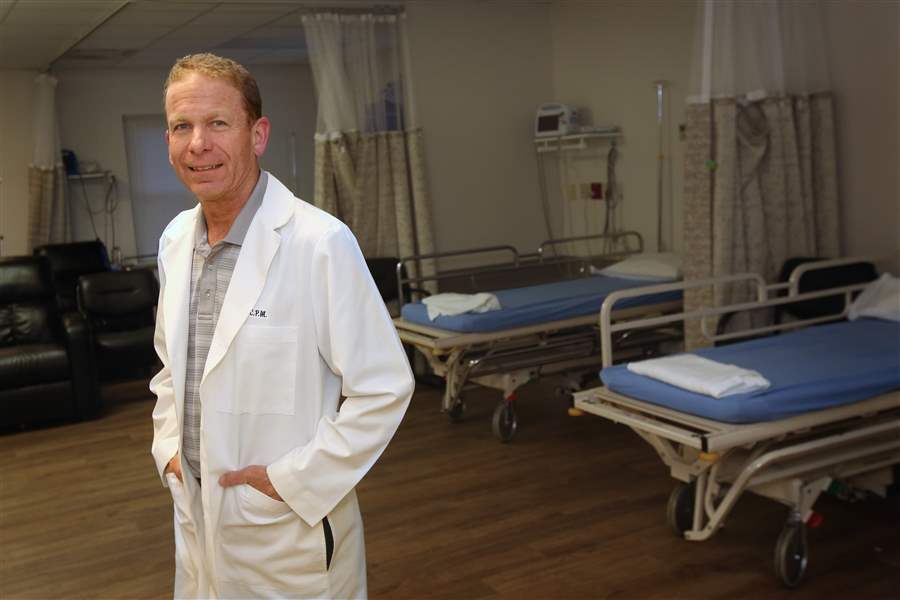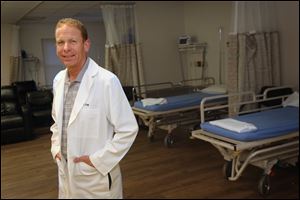
Ketamine novel approach to treating depression
Clinic opens in Toledo
6/25/2017
Anesthesiologist Dr. William James is the founder of the NorthWest Ohio Ketamine Clinic in Toledo, which offers the drug as an infusion to rapidly treat depression.
THE BLADE/KATIE RAUSCH
Buy This Image
Editor’s Note: This story has been corrected to show the Ohio State University’s medical center is the Wexner Medical Center.
After three years of ever-present suicidal thoughts and two decades of unrelenting, treatment-resistant depression, Rosemarie Barciz was desperate.
The 61-year-old Maumee woman researched every new medication that came onto the market or excited researchers.
Then four years ago she started to read about ketamine, an anesthetic used by physicians for decades that was gaining popularity as an antidepressant.

Anesthesiologist Dr. William James is the founder of the NorthWest Ohio Ketamine Clinic in Toledo, which offers the drug as an infusion to rapidly treat depression.
But it was little-used at the time and unavailable in the Toledo area until now, with the opening of the NorthWest Ohio Ketamine Clinic, which offers the treatment for depression heralded as an alternative to traditional medications and has been shown to work quickly in cases of crisis or suicidal ideations.
The clinic, within the Comprehensive Centers for Pain Management at 3400 Meijer Dr. in Sylvania Township, offers intravenous infusions of ketamine for both depression and pain management.
Ketamine has been around since the 1970s, when it was developed as an anesthetic widely used in human and veterinary surgeries. It also has been used as a club drug popular for its dissociative sensations and hallucinations, according to the U.S. Drug Enforcement Agency.
But used in a controlled setting in doses much smaller than for anesthesia and monitored by medical professionals, it can bring relief to patients who have not fared well under other depression treatments, said anesthesiologist and clinic founder Dr. William James.
“Major depressive disorder is a huge health-care problem in America, billions of dollars a year in lost productivity and health care are spent each year,” he said. “[For] people who have been resistant to traditional treatments, getting them back into the workplace, back into life, that’s a novel and remarkably efficient way to do it.”

Unlike traditional antidepressants that can take weeks to take effect, ketamine works rapidly, he said.
Patients must be referred to the clinic as part of their larger behavioral health treatment protocol, Dr. James said, and cannot come by self-referral.
Patients receive the ketamine treatment in a quiet room, relaxing in a chair with the option of soothing music. Though the dosage for depression does not cause sedation, someone must be there to drive the patient home.
Despite some doctors’ excitement over the treatment, it’s still relatively rare. Before the Toledo site opened, the closest option was Detroit or Cleveland, Dr. James said.
Cost is another factor.
Ketamine is approved by the U.S. Food and Drug Administration as an anesthetic but not as an antidepressant and is not covered by insurance, so patients have to pay out of pocket. A single infusion costs $720 at the Toledo site, with a recommended eight-infusion protocol. The $250 consultation fee is credited toward the first infusion if a patient begins treatment. Payment plans are available.
Ms. Barciz had found no success in the dozens of medications she was prescribed over the years until now. She recalled feeling better within days of her first treatment.
“I basically had become very isolated. I never left my home unless I absolutely had to,” Ms. Barciz said. “Most of my life I’ve lived with depression in this black hole.”
For Ms. Barciz, it’s been expensive but life-saving after years of paying for expensive prescriptions that didn’t work.
“It was as if a cloud lifted,” she said. “I no longer think of suicide every day. I’m getting out of the house, I’m doing things.” Her beloved garden grew wild and unkempt — or as she put it, “landscaping had gone all to hell” — but is now back in order.
Ketamine’s possibilities are intriguing, said Dr. Subhdeep Virk, a psychiatrist and assistant professor at Ohio State University’s Wexner Medical Center. “We are all excited,” she said. “We as providers in this field are looking for options for [preventing] suicides ... especially when young lives are affected and it can be prevented. I think this would really turn around the way we approach it.”
More than 44,000 Americans die by suicide each year, according to the American Foundation for Suicide Prevention. The National Institute on Mental Health estimated 16.1 million American adults in 2015 had at least one depressive episode in the last year.
Dr. Virk said more research needs to be done to better determine dosing and and long-term effects of the treatment.
Physicians and researchers don’t know exactly how long the treatments’ effects last, how often they should be prescribed for maximum benefit, or how often maintenance doses should be administered. But despite the uncertainty, Dr. Virk said she is hopeful.
“If this can be offered to people who really touched rock bottom and are looking for something to get them out of it, I hope this would be one of the options available,” she said.
Learn more about the NorthWest Ohio Ketamine Clinic at 419-344-0563 or nwohioketamineclinic.com.
Contact Lauren Lindstrom at llindstrom@theblade.com, 419-724-6154, or on Twitter @lelindstrom.